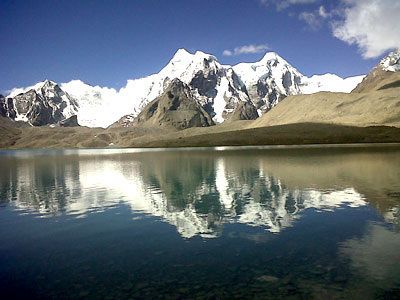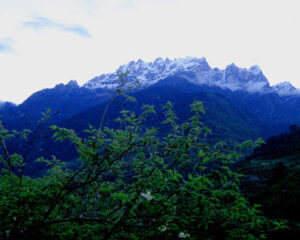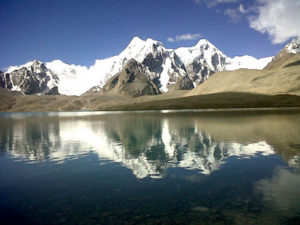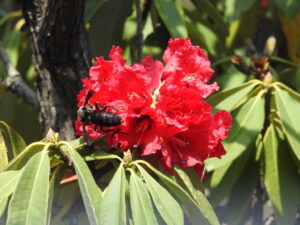
Pinaki Das, shares his experiences of Gurudongmar in Sikkim. The onset of summer reminds us each year of the call of the higher Himalayas that beckon insistently to old friend and newcomer, alike…
Gurudongmar in the Sikkim Himalayas
A childhood spent in the Aravallis, travelling stints with parents during school, a hiking club well used at College, a gradually developing spiritual quest and an innate love for nature. These are perhaps the reasons why a visit to the hills is always a priority among travel options. Every now and then, sucked into the mundane humdrum urban existence, there seems to be a divine call that says, “pack your bags and hit the Himalayas”.
One such call took my spouse Swati and I to “Nye-mae-el”, meaning Paradise. This is what the Lepcha or original inhabitants, called the beautiful land of Sikkim. We boarded a flight from Delhi to Bagdogra and then undertook a five hour road journey to Gangtok, where we reached around 7 pm.
After check-in at a pre-booked modest hotel, we proceeded to PUB 25 to celebrate our arrival. The backdrop of Clapton, Dire Straits and blues numbers made for a memorable evening in one of the best pub experiences I have known.
Gurudongmar, Yumthang and Yumsemdong in North Sikkim
Next morning, after completing permit formalities, we left for North Sikkim. Though there are exotic lesser known destinations across North Sikkim for travellers with niche interests like wildlife, trekking, culture and heritage, the standard 3 nights 4 days package covering Gurudongmar, Yumthang and Yumsemdong is highly recommended for a first time visitor.
 A seven hour drive in a Tata Sumo skirting numerous waterfalls including Meykong Falls and Seven Sisters Falls took us to our night halt at Lachen. Enroute, we had lunch at a modest hotel near Mangan. Sadly this area was in the news as the epicenter of the terrible earthquake that had killed many and destroyed landscape and structures. Gangtok to Lachen is around 130 kms with terrible hill roads for the first one third of the journey. We were lucky to have a local resident, Kenseng Bhutia, as our driver for the trip. He carried a vast collection of songs on his pen drive that keep us in good cheer. Around 20 kms before Lachen, there is the garrison town of Chungthang and the last stretch of the journey along the Lachen Chu river is very scenic. The milk white waters of the river reminded me of rivers like the Alaknanda or Kedar Ganga in Uttarakhand. The mountainous terrain around Lachen (altitude around 9000 ft) also lent a sense of deja vu.
A seven hour drive in a Tata Sumo skirting numerous waterfalls including Meykong Falls and Seven Sisters Falls took us to our night halt at Lachen. Enroute, we had lunch at a modest hotel near Mangan. Sadly this area was in the news as the epicenter of the terrible earthquake that had killed many and destroyed landscape and structures. Gangtok to Lachen is around 130 kms with terrible hill roads for the first one third of the journey. We were lucky to have a local resident, Kenseng Bhutia, as our driver for the trip. He carried a vast collection of songs on his pen drive that keep us in good cheer. Around 20 kms before Lachen, there is the garrison town of Chungthang and the last stretch of the journey along the Lachen Chu river is very scenic. The milk white waters of the river reminded me of rivers like the Alaknanda or Kedar Ganga in Uttarakhand. The mountainous terrain around Lachen (altitude around 9000 ft) also lent a sense of deja vu.
Journey to Gurudongmar Lake
After a quick dinner at Shangrila Retreat, it was time to retire early, as we planned to wake at 4 am for an 80 km drive to the rarefied air of Gurudongmar. On the eve of our journey to Gurudongmar, Kenseng advised us to strictly avoid alcohol in any form.
As planned, we left from Lachen at 4.30 am and after a two hour drive through rough terrain, we reached Thangu, at 13,000 ft. It was extremely cold and it was no surprise that the only grocery shop cum tea joint also sold liquor. We had our breakfast and picked up some snacks. Not being sure of the subsequent availability of celebratory C2H5OH for the evening after our anticipated conquest, I bought a bottle of rum. Our destination was still 5000 ft higher and 40 kms farther. The thin air made it difficult to smoke a cigarette in the officially smoke-free state, though there was hardly any enforcement beyond Gangtok city.
At Thangu, we were witness to the last bit of vegetation, which had gradually dropped from trees at 9000 ft in Lachen to mere shrubs and grass at 13000 ft. I had one last smoke, and as advised, kept munching popcorn, which made the journey easier. This last leg of the trip, had amazing cold desert visuals that reminded me of the pictures I had seen of Ladakh. We halted at 16000 ft at the Giyagong check post, where one can get a cup of coffee at a cafe, which might even be the world’s highest cafe. Sadly, no photography was allowed here. The 10-12 km journey from Giyagong to Gurudongmar Lake is breathtaking. It reminded me of extremely inhospitable but beautiful desert terrain of Afghanistan as shown in the movie: Bose, the Forgotten Hero.
As we trudged along another 6-7 kms, we spotted a trickle of water which was a spill-over from a nearby glacier. Soon, the snow capped Raja Parbat was visible, around 4-5 kms away from our destination – Gurudongmar.
By the time we reached Gurudongmar at 18,000 ft, high altitude sickness had hit. I felt groggy and immediately threw up. I felt better thereafter. It was around 8.30 am in the morning and perhaps the best time to be in Gurudongmar as visitors are not allowed after noon; conditions are extremely inhospitable thereafter. We were advised not to spend more than 30 to 45 minutes at the place because of the inhospitable conditions.
Gurudongmar Lake
 Then we saw a sight to remember – a huge celestial lake at the lap of the most beautiful glacier I had seen. Pristine blue water, clear as a crystal, shimmering like an emerald, surrounded by snowy peaks in front and barren mountains around. I sensed the mysticism, felt both awed and humbled by the beauty, and was aware of the blessing in being there. The imagery of the photographs we took will hopefully endure the rest of our lives.
Then we saw a sight to remember – a huge celestial lake at the lap of the most beautiful glacier I had seen. Pristine blue water, clear as a crystal, shimmering like an emerald, surrounded by snowy peaks in front and barren mountains around. I sensed the mysticism, felt both awed and humbled by the beauty, and was aware of the blessing in being there. The imagery of the photographs we took will hopefully endure the rest of our lives.
Gurudongmar gets just about 15,000 tourists a year and only about 10-15 vehicles per day in June and upto 100 vehicles per day during the peak season months of April and May. Mid June to mid September the monsoons make it near impossible for a visit. The lake can also be visited in the colder months of October till December but the visuals are different.
There is a temple maintained by the Army, where visitors of all religions offer prayers. Gurudongmar Lake is a holy place; reportedly due to visits by the venerated Second Buddha Guru Padmasambhava, after whom the lake is named. It is said that Guru Nanak also visited here. A portion of the lake close to the peak is of a different hue and it is said that this part of the lake does not get frozen even in peak winter. Legend has it that this is possible due to the blessings of the Gurus.
In the serenity around, I realized that contemplation was spontaneous. The beauty and mysticism of the place left me breathless, speechless and without thought. It was indescribable. My contemplative state continued through the drive to Lachen.
Yumthang
After a quick lunch, we bid adieu to Lachen and proceeded towards Lachung, our base for the next leg of our trip. The hotel we stayed at provided majestic sunrise views over snow capped mountains. Next morning we left for the famous Yumthang valley, just an hours drive away. There is a rhododendron trail after a wondrous waterfall.
In 2010, Yumthang, the valley of flowers (altitude 12,000 ft), had been host to the World Rhododendron Festival. When we were there, the valley had already passed its full bloom. Another 25 kms beyond Yumtahng is a cold desert destination, Zero Point, where the motorable road ends at an altitude of 16,000 ft. The mountainous scenery was amazing and it was interesting to notice the different hues of terrain in a cold desert like this. The place is full of snow till early May. It was June and most of the snow had melted. We spent an hour or so at Zero Point, which seemed like a popular tourist destination with lots of family tourists. On our way back from Zero Point, we stopped at Yumsemdong, which at 15,000 ft, is mid-way between Zero Point and Yumthang.
 Etymologically, rhododendron is derived from the ancient Greek word for rose, and closely related to the azalea. From Yumsemdong, one can spot a high altitude rhododendron trail with flowers of many coloured hue – red, pink, yellow, saffron and white. At this time of the year, we saw a lot of Primulas, which are a species of low growing herbs that were in full bloom in June.
Etymologically, rhododendron is derived from the ancient Greek word for rose, and closely related to the azalea. From Yumsemdong, one can spot a high altitude rhododendron trail with flowers of many coloured hue – red, pink, yellow, saffron and white. At this time of the year, we saw a lot of Primulas, which are a species of low growing herbs that were in full bloom in June.
We could spot yak in herds. We saw one with a white tail which is said to be a lucky omen. Thereafter, it was time for some meditative moments by the La Chung Chu river that flows through Yumthang valley. The riverside experience at Yumthang was simply wonderful. At around 1 pm, it turned cloudy and we came back to our base at Lachung, where we stayed overnight. The next day, after a 6 hour journey, we returned to Gangtok.
The following day in Gangtok, we ventured for some local sightseeing which included a visit to the Zoo to watch the Red Panda, which is the state animal. We also saw the Snow leopard and Tibetan wolf. The next day, we bid goodbye to “Nye-mae-el”.
“Like all great travellers, I have seen more than I remember, and remember more than I have seen.” ~ Benjamin Disraeli

Your new Format and Presentation have made it convenient to access my favourite ‘IT’ (india Travelogue)
Also, it has made it versatile with easier reference across its ever expanding content.
CONGRATULATIONS!
ks Krishnan (92) /
PS:-Having been associated with the Editor Madam Romola since first contributing to the site, one hopes, prayerfully, the valued one-to-one virtual-contact will continue despite technological advancements…
BEST WISHES.//